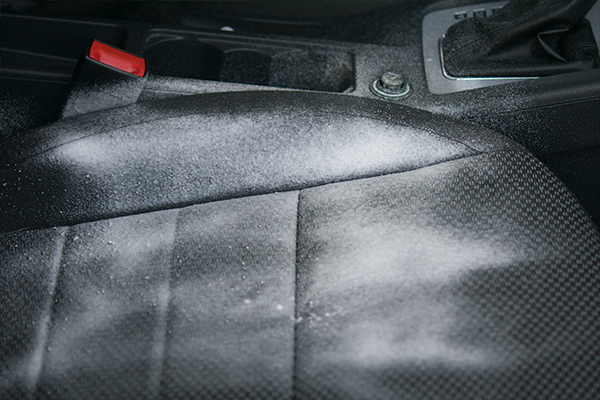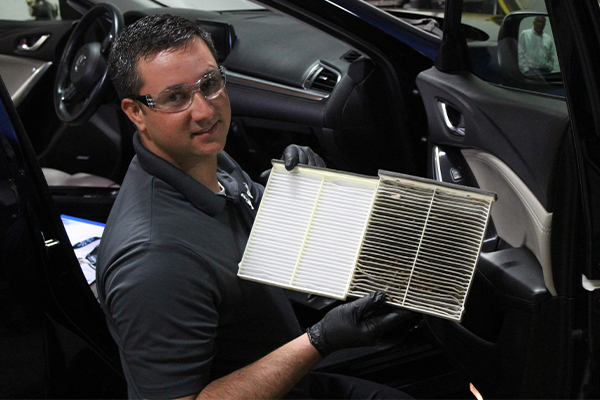Like most aspects of car ownership, dealing with dirty car seats can be a drag. You need to make time to follow through on the task, and the more time you waste may exacerbate the issue.
While spills and accidents can happen, the best way to stay ahead of messes on your car seats is to know how to clean them easily when disaster strikes. Let’s take a look at how you can keep your seats spotless, no matter which material you own, and what you need to do to take care of more specific issues.
What’s the best way to clean car seats?
When you’re looking to clean your car’s seats in the most efficient way possible, it’s important to remember that not all seat materials are equal. There are generally five different types of materials you can expect to find in any given car: nylon, polyester, vinyl, leatherette, and leather. Each one needs to be cleaned in a specific way to avoid damage, so here’s an easy breakdown:
Nylon
Nylon, or cloth, is an extremely common material for car upholstery. It has innate flexibility, which makes it a reliable option for long-term ownership. One downside to nylon is that it is an absorbent material, so anything from dirt and grime to spilled liquids poses a risk to their overall cleanliness.
If you’re looking to keep your nylon car seats looking clean, the first step should be to clean them off with a vacuum cleaner. When you use one of the finer attachments, you can easily get dirt or crumbs out of the cracks and seams.
For a deeper clean, you can’t go wrong with a sturdy scrubbing brush, mild cleaning solution, and some hot water. Be careful not to use so much water that your seats become saturated; this can result in the growth of mold or mildew (which we’ll talk about later in this article).
Polyester
Another car seat material is polyester, which is also referred to as “microsuede” for its similar look and texture to suede. While it excels as a more comfortable and higher-end looking material compared to nylon, it’s also more challenging to keep looking clean. That’s because it’s prone to picking up dirt and absorbing odors more than other upholstery types.
When you’re trying to clean your car’s polyester seats, be sure to use a mild fabric cleaner or all-purpose detergent and not too much water. Polyester can be stained and damaged from too much water absorption, so it’s crucial to spot clean if possible to avoid over-saturation.
Another tip to keep in mind with polyester is that improper cleaning can damage the material itself. While you may enjoy the soft material now, failing to take care of it can leave it stiff and uncomfortable. Personally, I’d avoid it altogether, but everyone has their preference. Just make sure you know how to keep it in good condition if you ever want to sell your vehicle.
Vinyl
Vinyl has been a common car upholstery option for decades, much beloved for its lower cost and easy cleaning process. Since it’s largely made from plastic, it’s a non-porous material, which makes cleaning a breeze. In most cases, a damp hand towel can tackle spontaneous spills or messes.
While vinyl is certainly easier to clean, it’s also susceptible to cracking over time. To prevent this, you need to routinely wash your car seats with a mild cleaning solution and apply a thin layer of vinyl protectant. This will ensure that sun exposure doesn’t cause irreparable UV damage to your seats.
Leatherette
Leatherette, or faux leather, has become more prevalent in recent years due to its leather-like appeal without the cost. Like vinyl, it’s relatively easy to clean. A once-over with your vacuum cleaner, followed by a damp cloth and soapy water is all you need to tackle stains that may accumulate over time.
One thing to keep in mind with leatherette is that it’s not as strong as typical leather. While it isn’t prone to cracking like vinyl seats, it can get very hot in summer conditions, resulting in stains from sweat or sunscreen residue.
Leather
The final and most luxurious seat material on this list is leather. While a more premium upholstery option, it’s notoriously harder to maintain than the other materials. A large component of that is because it needs to be routinely conditioned to avoid drying out or cracking.
If you’re looking to make your leather seats look spotless, then you need to start with the right cleaning products. Without them, you risk damaging your car seats from the get-go. Start by vacuuming up dirt and debris while taking care to avoid scratching your seat material. From there, use a microfiber towel and your leather cleaner of choice to wipe it down from top to bottom.
Leather conditioning is a routine process for keeping your seats looking as new as when you drove your car off the lot. It may be a pain to keep up with, but it’s worth the effort to prevent damage over time, like in the photo below.

How do I remove stains from my car seats?
Spontaneous stains on your car seats are frustrating to deal with, especially when they get to sink in for weeks or months. If you have cloth seats, then you’re likely to have more of a headache than other seat materials, because of how absorbent your upholstery is in comparison.
The best way to start dealing with a pesky stain on your car seat is with some warm water and baking soda. Mix up a solution with a few tablespoons of baking soda and gently apply it to the stain, making sure to not over-saturate the affected area with water.
For deeper, more stubborn stains, consider using a steam cleaner. You can choose to buy or rent one, whichever you prefer. With a steam cleaner in tow, you’ll be able to easily eliminate those annoying stains without relying on strong chemicals in your car.
Help! I have mold or mildew in my seats and don’t know what to do!
Mold or mildew in your car is no laughing matter. That’s not just a gross smell you have to deal with, it can also cause allergic reactions and harm your respiratory system over time if left unchecked.
When trying to remove mold from your car seats, be sure to start by wearing a mask to avoid breathing in mold spores. Then, make a solution that’s half white vinegar and half warm water, using a spray bottle to apply the solution onto your car seats. The beauty of white vinegar is that it has anti-fungal properties, so it can eliminate mold without the harmful risks of bleach.
Apply the vinegar solution thoroughly to your car seats and let it settle for a 15-20 minute period, before returning to assess the mold once again. You can reapply the vinegar solution after it’s dried, or use a wet-dry vacuum to suck up any lingering moisture in your car seats. Since mold thrives in moist environments, you’ll want to ensure that you’re leaving the car in a dry place, if possible. If you manage that, then you can keep this mold infestation at bay.
Finally, don’t forget to replace your cabin air filter. If mold has been growing in your car for a long period of time, it’s likely infiltrated your air filter and will still spread mold spores. Without changing the filter, you’ll be right back where you started.

Do you have dirty car seats that you’ve been dreading having to deal with? Fortunately for you, our mobile car care services are more widely available than ever!
Whether you need a thorough car seat cleaning or leather conditioning, our professional Spiffy Technicians are standing by to bring top-quality car detailing services to your home or office.
Check out our service menu and take $20 off of your first appointment today!
Posted in Car Care





